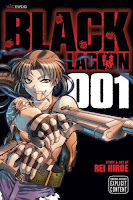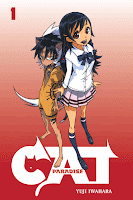My News and Reviews
The winner for Experiments in Manga’s latest manga giveaway was announced last week—Manga Giveaway: Hikaru no Go Giveaway Winner. As part of the contest I asked people to tell me about the manga that inspires them. There were some great responses, so I hope you’ll take the time to check them out. I also posted the September 2011 Bookshelf Overload, if anyone cares about that particular feature.
There are a few links I’d like to point out this week. First is an essay posted on the Comic Book Legal Defense Fund website that was written by Melinda Beasi of Manga Bookshelf—Voicing an Opinion: Manga Bookshelf’s Melinda Beasi Talks Canada Customs Case. Beasi’s arguments are very well stated and I support them fully. I also read an interesting interview with Sean Michael Wilson, who edited the first volume of AX: Alternative Manga among other things—From Scotland to Japan. There was also an nice look at Takehiko Inoue’s Vagabond that I came across—‘Vagabond’: Takehiko Inoue creates a samurai masterpiece. Vagabond is a fantastic series and I highly recommend it. I’ve reviewed the first omnibus volume as well as Eiji Yoshikawa’s novel Musashi on which the series is based.
Finally, there have been some blogs added to the Resource page, so give them a look: Chou-Dori, Nagareboshi Reviews, OtakuStew, Read About Comics.
Quick Takes
 Don’t Blame Me, Volumes 1-2 by Yugi Yamada. Don’t Blame Me is the first of Yugi Yamada’s works that I’ve read. It took a little while for the artwork to grow on me, but the story telling is excellent from the beginning. Don’t Blame Me doesn’t end with everything tied up nicely. Relationships are messy, complicated, and far from perfect. Yamada does a very nice job portraying this while still crafting a very satisfying ending. Additionally, Don’t Blame Me doesn’t just focus on the potential romance between the lead couple. Instead, there is a whole cast of characters that play an important part in the story. It’s nice to see everyone’s interactions and developing relationships.
Don’t Blame Me, Volumes 1-2 by Yugi Yamada. Don’t Blame Me is the first of Yugi Yamada’s works that I’ve read. It took a little while for the artwork to grow on me, but the story telling is excellent from the beginning. Don’t Blame Me doesn’t end with everything tied up nicely. Relationships are messy, complicated, and far from perfect. Yamada does a very nice job portraying this while still crafting a very satisfying ending. Additionally, Don’t Blame Me doesn’t just focus on the potential romance between the lead couple. Instead, there is a whole cast of characters that play an important part in the story. It’s nice to see everyone’s interactions and developing relationships.
 Kekkaishi, Omnibus 1 by Yellow Tanabe. I really enjoyed my first taste of Kekkaishi; its a lot of fun. A few things make it stand out for me among shōnen fighting series. First and foremost are the two main characters. Both are very strong in their own ways and complement each other nicely. Yoshimori may be more powerful, but his rival and potential love interest Tokine is more knowledgeable, practiced, and generally more competent than her younger neighbor. They are both well-rounded characters, especially Yoshimori. Another thing I really like about Kekkaishi is the magic system used. Tanabe comes up with some really creative uses and applications for the cuboid force fields that Yoshimori and Tokine can create.
Kekkaishi, Omnibus 1 by Yellow Tanabe. I really enjoyed my first taste of Kekkaishi; its a lot of fun. A few things make it stand out for me among shōnen fighting series. First and foremost are the two main characters. Both are very strong in their own ways and complement each other nicely. Yoshimori may be more powerful, but his rival and potential love interest Tokine is more knowledgeable, practiced, and generally more competent than her younger neighbor. They are both well-rounded characters, especially Yoshimori. Another thing I really like about Kekkaishi is the magic system used. Tanabe comes up with some really creative uses and applications for the cuboid force fields that Yoshimori and Tokine can create.
 Kiichi and the Magic Books, Volumes 1-5 by Taka Amano. As a librarian, I feel a certain affinity for Kiichi and the Magic Books. Mototaro reminds me a bit of Ginko from Mushishi, which is not a bad thing at all. The series starts out as a solid little fantasy, but ends up going in some strange directions. While there were some elements I really liked—especially the power granted to books and librarians—ultimately, I’m not sure I completely got or was really convinced by the world’s mythology. Still, I enjoyed the manga, particularly the earlier volumes. I think Kiichi and the Magic Books will probably appeal more to younger readers than older audiences, but there’s good stuff to be found and the artwork is nice.
Kiichi and the Magic Books, Volumes 1-5 by Taka Amano. As a librarian, I feel a certain affinity for Kiichi and the Magic Books. Mototaro reminds me a bit of Ginko from Mushishi, which is not a bad thing at all. The series starts out as a solid little fantasy, but ends up going in some strange directions. While there were some elements I really liked—especially the power granted to books and librarians—ultimately, I’m not sure I completely got or was really convinced by the world’s mythology. Still, I enjoyed the manga, particularly the earlier volumes. I think Kiichi and the Magic Books will probably appeal more to younger readers than older audiences, but there’s good stuff to be found and the artwork is nice.
 Kurozakuro, Volumes 1-2 by Yoshinori Natsume. I haven’t figured out exactly why, but Kurozakuro is surprisingly entertaining for such a mediocre series. There’s really nothing that makes it stand out story-wise or art-wise in these first two volumes and I’ve seen most of the plot elements before. Even the message the series is sending seems to be mixed. Mikito finally has the power to stand up for himself, but is basically told that he has to remain an underdog or die. However, I do like the change in art style between the dream sequences and reality, although the more abstract dream style occasionally bleeds over. Kurozakuro is only seven volumes, so it might be worth pursuing to see how and if it might improve.
Kurozakuro, Volumes 1-2 by Yoshinori Natsume. I haven’t figured out exactly why, but Kurozakuro is surprisingly entertaining for such a mediocre series. There’s really nothing that makes it stand out story-wise or art-wise in these first two volumes and I’ve seen most of the plot elements before. Even the message the series is sending seems to be mixed. Mikito finally has the power to stand up for himself, but is basically told that he has to remain an underdog or die. However, I do like the change in art style between the dream sequences and reality, although the more abstract dream style occasionally bleeds over. Kurozakuro is only seven volumes, so it might be worth pursuing to see how and if it might improve.
 Fullmetal Alchemist: Season 2, Part 1 (Episodes 29-40) directed by Seiji Mizushima. While I have seen the first season of Fullmetal Alchemist several times, this is the first time I’ve watched the second season. Much of this season is spent exploring the homunculi and their origins. I’m still not sure if there’s a deeper meaning to naming them after the seven deadly sins or not, but the symbolism certainly has the potential to be significant. There were a few twists thrown in that I probably should have seen coming but didn’t. Even if they were somewhat unexpected, they still make a lot of sense in the context of what came before. We learn more about Scar and his brother in these episodes, too.
Fullmetal Alchemist: Season 2, Part 1 (Episodes 29-40) directed by Seiji Mizushima. While I have seen the first season of Fullmetal Alchemist several times, this is the first time I’ve watched the second season. Much of this season is spent exploring the homunculi and their origins. I’m still not sure if there’s a deeper meaning to naming them after the seven deadly sins or not, but the symbolism certainly has the potential to be significant. There were a few twists thrown in that I probably should have seen coming but didn’t. Even if they were somewhat unexpected, they still make a lot of sense in the context of what came before. We learn more about Scar and his brother in these episodes, too.
 Seven Samurai directed by Akira Kurosawa. Seven Samurai was the first film by Akira Kurosawa that I ever saw and it remains my favorite. If you’ve never seen Seven Samurai before, you should really take the three and a half hours to watch it. Not only is it a good film, it’s also a highly influential one. The premise is fairly simple: a group of samurai is hired by a farming village to protect it from bandits. But first the villagers will have to find samurai willing to fight for them for very little pay and no glory. Fortunately, they come across the charismatic Shimada and are able to win him over to their cause. Soon, more samurai follow, each for their own reasons. That’s when the real battle starts.
Seven Samurai directed by Akira Kurosawa. Seven Samurai was the first film by Akira Kurosawa that I ever saw and it remains my favorite. If you’ve never seen Seven Samurai before, you should really take the three and a half hours to watch it. Not only is it a good film, it’s also a highly influential one. The premise is fairly simple: a group of samurai is hired by a farming village to protect it from bandits. But first the villagers will have to find samurai willing to fight for them for very little pay and no glory. Fortunately, they come across the charismatic Shimada and are able to win him over to their cause. Soon, more samurai follow, each for their own reasons. That’s when the real battle starts.










